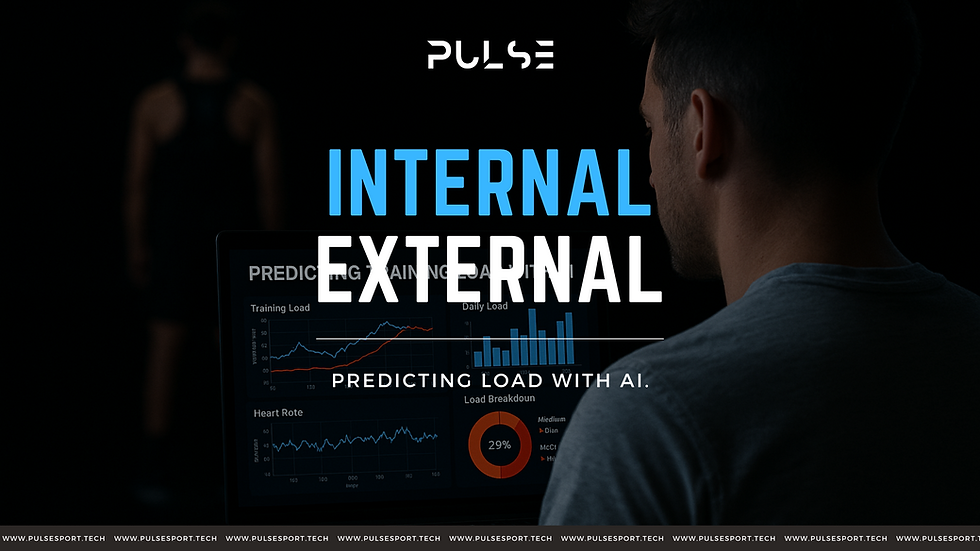Beyond Burnout: RED-S in Athletes, The Hidden Threat Draining Performance and Health
- Annikka Salathia
- Mar 28
- 4 min read

In the competitive world of athletics, the relentless pursuit of excellence can sometimes lead athletes into unintended health challenges. One such concern gaining attention is Relative Energy Deficiency in Sport (RED-S), a condition arising from an imbalance between energy intake and energy expenditure (5).
Understanding RED-S
RED-S occurs when an athlete's dietary energy intake fails to meet the energy demands of their training and daily activities, leading to low energy availability. It is not just an illness that affects top athletes; anyone, male or female, professional or amateur, can be affected (1). And it can lead to severe damage, weakening practically every system in the body if left untreated (3). This state affects various physiological functions, including metabolism, menstrual function, bone health, immunity, protein synthesis, and cardiovascular health (2). Initially recognised as the Female Athlete Triad—comprising disordered eating, amenorrhea, and osteoporosis—the concept has evolved to encompass a broader spectrum of health and performance consequences (5).
Health Implications
The consequences of RED-S are extensive and multifaceted. Metabolically, athletes may experience a reduced resting metabolic rate as the body attempts to conserve energy (3). Reproductive health is also affected; women may face menstrual dysfunctions such as amenorrhea, while men might experience decreased testosterone levels, impacting libido and reproductive health. Bone health is particularly concerning, as chronic energy deficiency can lead to decreased bone mineral density, increasing the risk of stress fractures and osteoporosis (2). Cardiovascular complications, including bradycardia (slowed heart rate), have been observed in athletes with RED-S (3). Psychologically, mood disturbances, including depression and irritability, are common among those affected by RED-S (8). Reduced bone density, cardiovascular problems, gastrointestinal disorders, and weakened immunity are only a few of the long-term effects of RED-S (5).

Recognizing RED-S
Owing to the various organ systems that are impacted, athletes may experience a wide range of symptoms, such as persistent exhaustion, anaemia, frequent colds and infections, diminished performance, stress fractures, repeated bone injuries, diminished strength, difficulty gaining muscle mass or strength, irregular or nonexistent menstruation, intense training that yields little to no results, gastrointestinal issues, weight loss or lack thereof despite eating less, changes in body composition (increased fat mass), irritability, and disturbed food-related thoughts (7). Identifying RED-S can be challenging due to these broad ranges of symptoms. Athletes, coaches, and healthcare professionals should be vigilant for signs such as persistent fatigue, declining performance, frequent injuries (particularly stress fractures), menstrual irregularities in women, and mood changes (8).
Addressing and Preventing RED-S
Because RED-S can be so slow to detect, a diagnosis also indicates a long recovery period. Both physical and mental health must be taken into account in order to treat it properly (3). Education is paramount; athletes and coaches should be informed about the importance of adequate nutrition and the risks associated with energy deficits (6). Consulting with sports dietitians can help tailor dietary plans that meet the energy demands of training and competition. Regular health check-ups, including assessments of bone density and hormonal levels, can aid in early detection. Additionally, mental health professionals can provide support to address any underlying disordered eating behaviours or psychological stressors (8).
Some points of attention for prevention of RED-S that athletes and coaches can look after include:
Avoid strict diets and an energy intake that is far too low.
Spread your energy intake throughout the day and around workouts.
Monitor the timing and quality of protein intake.
Distribute carbohydrate intake according to workouts.
Pay attention to your recovery.
Favour foods with a low energy density.
Avoid high-fat diets and one-sided diets that completely eliminate certain foods (except in cases of food sensitivity) (7).
To conclude, while the pursuit of athletic excellence is commendable, it's crucial to balance training with proper nutrition and recovery. Recognizing and addressing RED-S is essential to safeguard the health and performance of athletes at all levels (8).
Bibliography :
Brown University (no date) Relative Energy Deficiency in Sport (RED-S) | Health Promotion | Brown University. Available at: https://www.brown.edu/campus-life/health/services/promotion/nutrition-eating-concerns-sports-nutrition/relative-energy-deficiency-sport-red-s (Accessed: 19 March 2025).
Cabre, H.E. et al. (2022) Relative energy deficiency in sport (red-S): Scientific, clinical, and practical implications for the female athlete, Deutsche Zeitschrift fur Sportmedizin. Available at: https://pmc.ncbi.nlm.nih.gov/articles/PMC9724109/ (Accessed: 19 March 2025).
Dave MD, S.C. and MD, M.F. (2022) Relative energy deficiency in sport (red – S), Science Direct. Available at: https://www.sciencedirect.com/science/article/pii/S1538544222001110 (Accessed: 19 March 2025).
Dooney, E., Carter, K. and Smyth, D. (2025) Red-S: The condition all runners need to know about, Runner’s Worlds. Available at: https://www.runnersworld.com/uk/health/a33589189/red-s-relative-energy-deficiency-running/ (Accessed: 19 March 2025).
Mountjoy, M. et al. (2023) 2023 International Olympic Committee’s (IOC) consensus statement on Relative Energy Deficiency in sport (reds), British Journal of Sports Medicine. Available at: https://bjsm.bmj.com/content/57/17/1073?__cf_chl_rt_tk=JszuZ1QoqUuKM8uDP1EgjIeOwExRn2aDTH6z1_AMfyM-1742208291-1.0.1.1-wOqokm8Gkz4wCmT9cTao_ThrCMSqh092MEww1.haHcU (Accessed: 19 March 2025).
Project Red-S: Founder pippa’s story (no date) red-s.com. Available at: https://red-s.com/articles/founder-pippas-red-s-story (Accessed: 19 March 2025).
Ridder, I.D. (2020) Syndroom red-S: Relatief Energietekort in De Sport, Voedingsinfo NICE. Available at: https://www.nice-info.be/nutrinews/syndroom-red-s-relatief-energietekort-de-sport (Accessed: 19 March 2025).
Woolven, P. (2025) Rediscovering balance: My journey with reds and disordered eating, National Eating Disorders Association. Available at: https://www.nationaleatingdisorders.org/reds-and-disordered-eating/ (Accessed: 19 March 2025).



Besides low energy intakes, could REDs actually happen because of high training loads (e.g., ACWRs in red zones for too long)? I can imagine that if that’s the case, the athlete is just not adapting to the load put on him, and that could be whether energy intakes are low or enough
quite interesting, might be one of the main reasons for overtraining syndrome. What are the sports where RED-S syndrome happens the most? important information to know for coaches and medical practicioners in sports organisations. There must be a correlation between sports and RED-S rate amongs athletes...